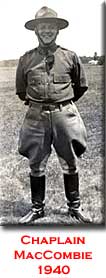Chaplains of the
36th Infantry Division
by
Chaplain (Colonel) Herbert E. MacCombie
Division Chaplain
Joining the 36th Infantry
Division
 I was inducted into the service for
World War II with the 103rd Field Artillery of the Rhode Island National
Guard. At that time the rank of a chaplain was determined by the length
of his military service. Because I had service (in the Infantry) going
back to World War I, I was promoted to Lieutenant Colonel in August 1942.
Thus I was a regimental chaplain with the rank of Lieutenant Colonel. I was inducted into the service for
World War II with the 103rd Field Artillery of the Rhode Island National
Guard. At that time the rank of a chaplain was determined by the length
of his military service. Because I had service (in the Infantry) going
back to World War I, I was promoted to Lieutenant Colonel in August 1942.
Thus I was a regimental chaplain with the rank of Lieutenant Colonel.
When Chaplain Chaitangion was
promoted to Corps Chaplain, a vacancy was created in the office of the
Division Chaplain of the 36th Division. At that time the report of
religious preference in the division showed that forty percent of the men
were Baptist. The Chief of Chaplains decided that this was an ideal spot
for a Baptist Lieutenant Colonel, and I was ordered to duty with the 36th
Division. They didn’t realize that to Texans the place of a man’s birth
was more important than his religious designation.
I reported for duty on April 19,
1942. On April 21st a division parade was held. While talking with a
group of staff officers I asked what the occasion for the parade might
be. They told me, “This is San Jacinto Day!” In my ignorance I asked,
“What is San Jacinto Day?” They were aghast. After a few minutes of
silence, Lieutenant Colonel Moseley (the Division Judge Advocate) replied,
“What the Battle of Lexington and Concord is to you damnedyankees, San
Jacinto is to us Texans”. Then I understood, but for a long time I was
the Damnedyankee Chaplain.
At that time we were anticipating
early combat duty. In May 1942 the Commanding General authorized a School
of Chaplains. The school lasted for two weeks. The school staff included
Major Benjamin Primer, 111th Medical Battalion (First Aid); Captain Oran
C. Stovall, 111th Engineer Battalion (Map Reading and Sketching); Captain
Edwin N. Harris (Defense against Chemical Warfare); 2nd Lieutenant Lee F.
Allison, (Graves Registration and Burials). We were also helped by
Captain Walter R. Keough of the 111th Medical Battalion, and the 1st
Platoon of Company E, 143rd Infantry, headed by Sergeant Harvey L. Odom.
At the conclusion of the school a
field exercise was held that tested the training that had been given in
the course. Seven chaplains achieved a rating of “satisfactory”; four
were rated “very satisfactory”. None of them failed the course. In the
report to the Commanding General there were included two commendations:
one for Captain Oran C. Stovall, which stated that several of the
chaplains said that under the leadership of Captain Stovall they learned
more than in any similar experience; the second commendation was given to
the men of the first platoon of Company E of the 143rd Infantry.
[
PREVIOUS | NEXT ]
Copyright 2001
by Mary MacCombie Fietsam
Printed by Permission |

